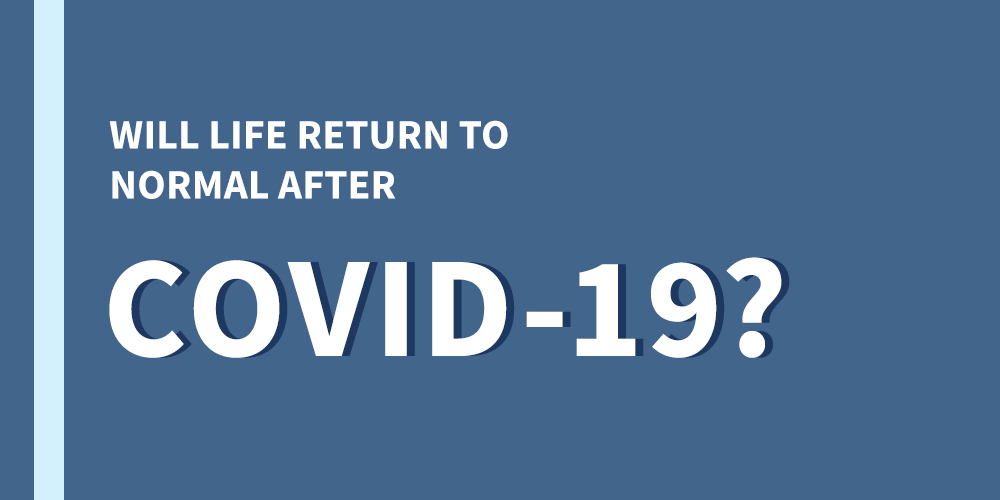In the aftermath of the Great Recession, the media was abuzz with talk about a “new normal.” As charitable giving rebounded and dollar totals exceeded pre-recession levels, we were tempted to believe things really had returned to normal. But then we began to see the subtle differences of that new normal: growth in overall giving was increasingly being driven by large donors, popularity of donor advised funds diverted dollars away from front-line nonprofits to intermediaries, and giving from mid-level and small donors continued to erode.
We can guess that when the coronavirus crisis is behind us, we will be talking about a new, new normal.
What the future will be is uncertain, but nonprofits and professional fundraisers should be thinking about that future now. That means identifying emerging challenges and opportunities, anticipating continuing disruptions, brainstorming about alternative futures, and anticipating strategic directions.
We offer the following comments and questions as a place to kick-start strategic conversations within your nonprofit. Keep in mind that none of us have the answers—as is always the case with strategic thinking. The point, though, is to be engaged with your changing environment and envision your organization’s possible futures based on anticipated realities.
The way out of a crisis is to think through it.
Board and Executive Leadership
Does each executive leader and every board member understand the impact of this crisis on your organization? Since the extent and nature of the crisis and its resolution will change rapidly, apprising your organization’s leaders must be dynamic and continual. Leaders need to be thinking about the best- and the worst-case scenarios for your organizations and planning now for future eventualities.
Giving
What, realistically, can your organization expect from its donors, now and when this crisis has passed? How will the crisis have affected individual donors? Who may have “weathered” the virus? The financial uncertainty? How do you anticipate that provisions in crisis relief legislation, specifically the CARES Act, will influence giving behavior of your donors? For example, is the deduction for cash donations of up to $300 for non-itemizing taxpayers likely to boost small contributions among your donors? Or will the allowance for charitable deductions of up to 100% of AGI for itemizers significantly increase the likelihood of large contributions? Will the increase in the tax deduction limit from 10% to 25% result in increased corporate giving or will business losses preclude any real gains? What are your plans for educating your donors about these and other new tax incentives?
The Economy and Consumer Confidence.
During the Great Recession, we know giving generally declined in concert with the economy and consumer confidence; it trailed them in recovery. Was this true for your donors then? If so, is it likely it will be true this time, too?
Given the drastic shock to the economy and employment from shuttering businesses and entertainment venues and issuing stay-at-home orders, we can assume a decline in giving for many organizations. But when will it rebound? In the best case, we can hope that the economic recovery will be fast and dramatic. But that is probably not going to be reality. Nonprofits must anticipate possible longer-term effects from a slow recovery or worse. Is your nonprofit developing various scenarios for the near term? For the long-term? For something in between?
Government Grants
Given the enormity of the federal relief appropriations and the unbudgeted interventions by state and local governments, conventional grant programs will surely be impacted. Some of the relief measures, including the CARES Act, offer financial support to nonprofits through government programs such as the National Endowments for the Arts and Humanities, but the competition for these funds will be fierce. How dependent is your nonprofit on government grants? What are the realistic alternatives for program delivery if this source of funds disappears?
Postal Service
With the crisis-caused decline in mail volume, the United States Postal Service is now facing the possibility of running out of funding and halting operations this summer. Some lawmakers and the current administration are not only opposing any crisis assistance to avert this possibility but promoting the idea of privatizing mail delivery instead. What will this mean for nonprofits who rely on direct mail? What effect will privatization have on nonprofit postal rates? While on-line giving and digital fundraising have grown steadily in the past few years, is your nonprofit prepared for an accelerated use of these options?
Virtual Donor Engagement and Stewardship
The pandemic caused many nonprofits to cancel fundraising events or to transform them into “virtual” experiences. What lessons will we have learned from this forced change? Did donors respond as robustly as they would have if the event had been held? Does the virtual option allow nonprofits to reconsider the cost-benefit of real vs. virtual fundraising events in the future?
Many organizations also found innovative and creative ways to engage their donors and their other constituents through such venues as Facebook Live and YouTube videos. Has this necessity created new ways of thinking about effective donor stewardship and volunteer engagement in your organization? If so, what resources and talents will your nonprofit need to sustain these activities?
The Workplace
Working from home has changed the workplace. While many nonprofits have experimented with working-from-home options in the past, almost none required everyone to work remotely every day. What lessons have we learned from this forced experience? Can workplace rules be more flexible to meet employee preferences and not harm program and service delivery? Can expanded work-from-home provisions reduce the fixed costs of office space? Can we find economies in holding more virtual meetings by reducing travel time and costs? Are donors comfortable with virtual visits? Are they more likely, as a result of social distancing, to welcome phone calls and personal visits?
Values and Donor Behavior
We know crises can reshape society. As we live through this crisis, will we become more empathetic, more altruistic, more cautious, less or more polarized, less self-oriented and more communal? Will what we have experienced during this crisis change organizational values and donor behavior? There are a number of possibilities for changes in values and behaviors, and we should be acutely attuned to our constituents, our donors, and our communities in order to respond to the possibilities of a new social order.
So, we re-frame our initial question: Should life return to normal after Covid-19? Probably not. Rather, we should aspire to what Madeleine Albright, former Secretary of State, has said about this crisis: “It might do well for us to view these abnormal days as an opportunity to ask more of ourselves, to reflect on our relations with one another, and think critically about improving the social, economic, and political structures that shape our lives. We can draw inspiration from those who have surmounted high obstacles in the past, and vow to make the new normal that we aim to bring about better, more just and more secure than the old."
Looking for guidance on crisis recovery? TW&B can help. Connect with one of our senior-level consultants here.


Comments
Questions or comments? Join the conversation!